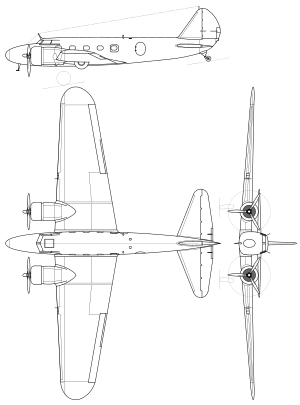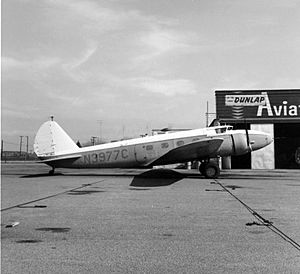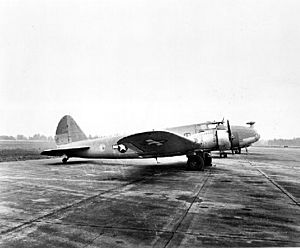Boeing 247 facts for kids
Quick facts for kids Boeing 247 |
|
|---|---|
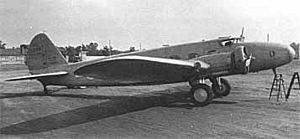 |
|
| Boeing 247 prototype at Boeing Field, c. 1933 | |
| Role | Passenger airliner |
| Manufacturer | Boeing |
| First flight | February 8, 1933 |
| Introduction | May 22, 1933 |
| Status | Retired |
| Primary user | Boeing Air Transport |
| Number built | 75 |
The Boeing 247 was an important American airliner. It was one of the first planes to use many advanced features. These included landing gear that could fold up into the plane. It also had an autopilot system and special deicing boots to stop ice from forming on the wings.
The Boeing 247 first flew on February 8, 1933. It started carrying passengers later that year. This plane helped change how airliners were designed. It led to bigger planes with more engines, like the Boeing 307 Stratoliner.
Contents
How the Boeing 247 Was Designed
The Boeing 247 was a very modern plane for its time. Its design came from earlier Boeing planes, like the Boeing Monomail and the B-9 bomber. The 247 was even faster than the main American fighter plane of that time, the Boeing P-12. That fighter plane had an open cockpit and two sets of wings (a biplane).
The Boeing 247 could land quite slowly, at just 62 miles per hour. This meant it didn't need special flaps on its wings. Also, its back wheel lifted off the ground at only 10 miles per hour. This made it easier for pilots to steer the plane on the ground.
The 247 was also the first two-engine airliner that could keep flying even if one engine stopped working. It had special propellers and could fly at 11,500 feet, even when fully loaded. Other planes, like the Douglas DC-1, used some of the Boeing 247's ideas. The plane was first planned to carry 14 passengers. It was also supposed to have powerful Hornet engines. But the design was changed, making the plane smaller and giving it different engines.
Some pilots worried that the plane, which weighed eight tons, was too heavy for the runways of the time. They also preferred a different type of engine, the Wasps, over the Hornet engines. They thought the Hornets were too powerful. Even with these concerns, the 247 was a great design. Boeing showed it off at the 1933 Chicago World's Fair.
Boeing wanted the plane to be very safe and comfortable. The cabin had air conditioning and was sound-proof. The plane carried a pilot, a co-pilot, and a flight attendant. A part of the landing wheels always stayed visible below the plane. This was a safety feature. If the landing gear couldn't come down, the plane could still land more safely on these parts of the wheels. The wheel at the back of the plane could not be moved.
History of the Boeing 247
In 1934, a Boeing 247 took part in the MacRobertson Race. This was a famous race from England to Australia. The pilots, Col.Roscoe Turner and Clyde Pangborn, flew a mostly normal 247. They removed some parts to add more fuel tanks. Many planes from around the world competed. The Boeing 247 came in second place, right after a Douglas DC-2.
The Boeing 247 won the 1934 US Collier Trophy. This award is given for "excellence in aviation design."
The 247 could fly across the United States much faster than any plane before it. It cut travel time by eight hours. The Boeing 247 started flying passengers on May 22, 1933. One plane set a record, flying from San Francisco to New York City in just 19 and a half hours.
The first 60 Boeing 247s were sold to Boeing Air Transport. This company was part of United Aircraft and Transport Corporation (UATC). Each plane cost $65,000. Another airline, TWA, also wanted to buy the 247. But UATC said no. So, TWA's President, Jack Frye, asked Don Douglas to design a new airliner. This led to the Douglas DC-1 and later the very popular Douglas DC-3.
The Boeing 247 had one main problem for airlines: it could only carry 10 passengers. The DC-2 and DC-3 could carry many more. This meant the Boeing 247 would not make as much money for airlines.
In total, 75 Boeing 247s were built. In comparison, Douglas received 800 orders for DC-3s before the Pearl Harbor attack. Douglas ended up building over 10,000 DC-3s.
Many of United's Boeing 247s were later bought by Western Air Express at a very low price.
The 247 was used until World War II. The Royal Canadian Air Force (RCAF) used seven 247s to move soldiers. Some 247s were still flying in the late 1960s, used as cargo planes or private planes.
Boeing 247 Accidents
- October 10, 1933 – A United Air Lines 247 was damaged by a bomb.
- November 9, 1933 - A United Air Lines 247 crashed after taking off. Four of the nine people on board died.
- December 20, 1934 - United Air Lines Flight 6, a 247, crashed near Western Springs, Illinois. No one died. The plane was fixed and flew again.
- October 7, 1935 – United Air Lines Trip 4, a 247D, crashed near Cheyenne, Wyoming. Everyone on the plane died. The reason for the crash is not known.
- October 30, 1935 - A United Air Lines Boeing 247D crashed near Cheyenne. Everyone on board died.
- December 15, 1936 – Seven people died when Western Air Express Flight 6, a 247D, crashed on Lone Peak in Utah.
- December 27, 1936 - United Air Lines Trip 34, a 247D, crashed in Los Angeles County, California. All 12 people on board died.
- January 12, 1937 – Western Air Express Flight 7, a 247, crashed into a mountain in Newhall, California. Five people died.
Different Kinds of Boeing 247
- 247: This was the first type of the plane made.
- 247A: This was a special order for a German airline called Deutsche Luft Hansa.
- 247E: This name was given to the very first Boeing 247 plane ever built.
- 247D: This version was first made for the MacRobertson Race. It had special propellers that made the plane 7 mph faster.
- 247Y: This was a version of the plane that was fitted with guns.
Who Used the Boeing 247?
Airlines
 Brazil Viação Aérea Bahiana (used one plane)
Brazil Viação Aérea Bahiana (used one plane) Canada Canadian Pacific Airlines
Canada Canadian Pacific Airlines- Quebec Airways
 Colombia Avianca (used 10 planes)
Colombia Avianca (used 10 planes) Germany Lufthansa (used four planes)
Germany Lufthansa (used four planes) United States Boeing Air Transport (later United Air Lines) (used 60 planes)
United States Boeing Air Transport (later United Air Lines) (used 60 planes)- Empire Air Lines
- National Parks Airways
- Pennsylvania Central Airlines
- United Aircraft Corporation (used 10 planes)
- Wien Air Alaska
- Western Airlines
- Woodley Airways
- Wyoming Air Service
Military
 Canada Royal Canadian Air Force
Canada Royal Canadian Air Force United Kingdom Royal Air Force
United Kingdom Royal Air Force United States United States Army Air Corps
United States United States Army Air Corps
Boeing 247 Planes Still Around Today
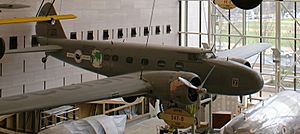
- c/n 1699, CF-JRQ: This plane is at the Canada Aviation Museum in Ottawa. It was given to the museum in 1967.
- c/n 1722, N18E: This plane is at the National Museum of Science and Industry in Wroughton, UK.
- c/n 1729, N13347: This plane can still fly! It is at the Museum of Flight Restoration Center, near Paine Field in Snohomish County, Washington, USA.
- c/n 1953, NC13369 / NR257Y: This plane is in the Hall of Air Transportation at the National Air and Space Museum in Washington, DC, USA. It is painted in United Air Lines colors.
Facts About the Boeing 247D
Data from The Concise Guide to American Aircraft of World War II
General characteristics
- Crew: three
- Capacity: ten passengers
- Length: 51 ft 5 in (15.7 m)
- Wingspan: 74 ft 1 in (22.6 m)
- Height: 12 ft 5 in (3.8 m)
- Wing area: 836.4 ft² (78 m²)
- Empty weight: 8,921 lb (4,055 kg)
- Max. takeoff weight: 13,650 lb (6,190 kg)
- Powerplant: 2 × Pratt & Whitney S1H1-G Wasp radial engine, 550 hp (410 kW) each
Performance
- Maximum speed: 200 mph (320 km/h)
- Cruise speed: 188 mph (304 km/h)
- Range: 745 miles (1,200 km)
- Service ceiling: 25,400 ft (7,620 m)
- Rate of climb: 1,148 ft/min (350 m/min)
Images for kids
-
United Airlines crew members and employees stand in front of a Boeing 247
See also
 In Spanish: Boeing 247 para niños
In Spanish: Boeing 247 para niños


